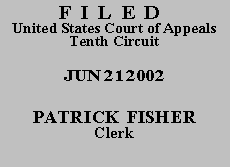

UNITED STATES COURT OF APPEALS
| JASON BLAKE SHOEMAKE,
Petitioner - Appellant, v. ELVIS HIGHTOWER, Respondent - Appellee. |
No. 02-7008
|
On April 7, 1994, Shoemake pled guilty to two counts of unlawful delivery of amphetamine within one-thousand feet of a school. He received two five-year deferred sentences, but on September 15, 1995, the deferred sentences were accelerated due to a parole violation. Shoemake did not seek to withdraw his plea or appeal to the Oklahoma Court of Criminal Appeals, so his conviction became final ten days after his sentencing at the acceleration hearing. See Okla. Stat. tit. 22, Ch. 18, App., Rule 4.1 (1986) (current version at Rule 4.2). His conviction thus became final on September 25, 1995. Shoemake did not file an application for post-conviction relief in state court until April 28, 2000. The application was denied, and that decision was affirmed on appeal on August 8, 2000. Shoemake filed a petition for a writ of habeas corpus on April 30, 2001.
This Court may issue a COA only if an applicant "has made a substantial showing of the denial of a constitutional right." 28 U.S.C. § 2253(c)(2). Meeting this standard requires "a demonstration that . . . includes showing that reasonable jurists could debate whether (or, for that matter, agree that) the petition should have been resolved in a different manner or that the issues presented were 'adequate to deserve encouragement to proceed further.'" Slack v. McDaniel, 529 U.S. 473, 484 (2000) (quoting Barefoot v. Estelle, 463 U.S. 880, 893 n.4 (1983)). We review the legal conclusions of a district court in a habeas proceeding de novo. Martin v. Kaiser, 907 F.2d 931, 933 (10th Cir. 1990).
Pursuant to the Antiterrorism and Effective Death Penalty Act of 1996 ("AEDPA"), a state prisoner generally has one year from the date his conviction becomes final to file a petition for a writ of habeas corpus in federal court. See 28 U.S.C. § 2244(d)(1) ("A 1-year period of limitation shall apply to an application for a writ of habeas corpus by a person in custody pursuant to the judgment of a State court."). Because Shoemake's conviction became final before April 24, 1996--the effective date of AEDPA--he had until April 23, 1997, to file his habeas petition. See Miller v. Marr, 141 F.3d 976, 977 (10th Cir. 1998). Although the AEDPA period of limitation is tolled during the time in which a "properly filed application for State post-conviction or other collateral review with respect to the pertinent judgment or claim is pending," 28 U.S.C. § 2244(d)(2), Shoemake's state post-conviction actions cannot toll the period of limitation because they were filed well after the April 23, 1997 date on which his habeas petition was due.
The district court correctly determined that Shoemake's habeas petition was time-barred. Shoemake's application for a COA is DENIED. His motion to proceed in forma pauperis is GRANTED.
The mandate shall issue forthwith.
ENTERED FOR THE COURT
Carlos F. Lucero
Circuit Judge
*. The case is unanimously ordered
submitted without oral argument pursuant
to Fed. R. App. P. 34(a)(2) and 10th Cir. R. 34.1(G). This order and judgment is
not binding precedent, except under the doctrines of law of the case, res judicata,
and collateral estoppel. The Court generally disfavors the citation of orders and
judgments; nevertheless, an order and judgment may be cited under the terms and
conditions of 10th Cir. R. 36.3.
Click footnote number to return to corresponding location in the text.
![]() | Keyword |
Case |
Docket |
Date: Filed /
Added |
| Keyword |
Case |
Docket |
Date: Filed /
Added |
![]() (27863 bytes)
(27863 bytes)
![]() (14829 bytes)
(14829 bytes)
Comments to: WebMaster,
ca10 [at] washburnlaw.edu.
Updated: June 24, 2002.
HTML markup © 2002, Washburn University School of Law.
URL: http://ca10.washburnlaw.edu/cases/2002/06/02-7008.htm.